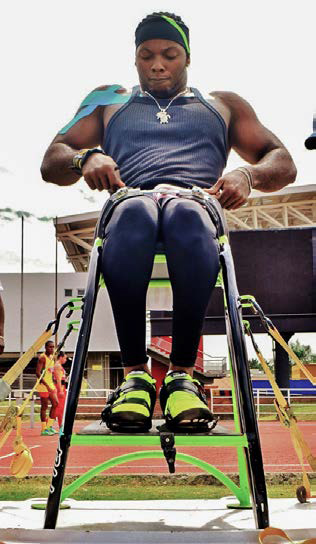Centaurum Black- chair for discus, bullet and javelin throwing competition aimed at athletes who present with cerebral paralysis
##plugins.themes.bootstrap3.article.main##
Abstract
Understanding design as a scientific project discipline that seeks innovative solutions to problems at different scales related to well-being, it is inferred that the designer, as creator of the things of the future, must guarantee that the common goods and the heritage of the generations remain with time. This sensitive idea commits him to the search for innovative solutions within the framework of social inclusion and the construction of citizenship, since the growing population in a situation of disability, excluded in many areas of daily life, falls into marginalization and self-marginalization. It is then the obligation of the designer to find mechanisms to ensure participation in the dynamics of everyday life, which makes design a democratic discipline. Sport is one of those scenarios from which these people usually remain isolated. Centaurum Black was developed to transform it into a mechanism for participation and inclusion of the population in a situation of disability.
##plugins.themes.bootstrap3.article.details##

This work is licensed under a Creative Commons Attribution-NonCommercial-ShareAlike 4.0 International License.
- Attribution — You must give appropriate credit , provide a link to the license, and indicate if changes were made . You may do so in any reasonable manner, but not in any way that suggests the licensor endorses you or your use.
- NonCommercial — You may not use the material for commercial purposes .
- No additional restrictions — You may not apply legal terms or technological measures that legally restrict others from doing anything the license permits.
- ShareAlike — If you remix, transform, or build upon the material, you must distribute your contribution under the same license as the original. NOTE: This point applies to numbers 1 to 20 of the magazine with the previous CC-BY-NC-SA 4.0 license. Does not apply to the new CC BY-NC 4.0 license from Volume 11, Number. 21 (2024).
References
Cohen, D., Sargeant, M. y Somers, K. (2014). 3-D prin- ting takes shape. pp. 1–6.
Comité Español de Representantes de Personas con Discapacidad (CERMI). (2005). Ayudas técnicas y disca- pacidad. ISBN: 84-609-5203 7
Decisiones, H.D.E.T.D.E. et al., Análisis tecnológi- co (diagnóstico tecnológico): herramienta de toma de decisiones, inteligencia empresarial y gestión del conocimiento.
Discapacidad, C.O.N., Convención sobre los Dere- chos de las Personas con Discapacidad y Protocolo Facultativo.
Discapacidad e Inclusión Social (2010), Reflexiones des- de la Universidad Nacional de Colombia. Juan Guerre- ro. 2.3 .Discapacidad, discapacitados y expertos p.82.
Discapacidad y posconflicto en Colombia. Eleuthera. Vol. 12, enero-junio 2015, págs. 131-140.
Dorantes-Mendoza et al., (2007). Factores asociados con la dependencia funcional en los adultos: un aná- lisis secundario del Estudio Nacional sobre Salud y Envejecimiento en México, 2001.
García-Acosta, G. (2014). La ergonomía desde la vi- sión sistémica.
Gómez, J. C. (2010). Discapacidad en Colombia: Reto pa- ra la Inclusión en Capital Humano. Fundación Sal- darriaga Concha. Colombia.
IMSERSO. (2006). El Libro Blanco. Conceptualización de la dependencia y su impacto sobre la población a proteger. Cuarta etapa. España
Laloma Miguel. (2005). Ayudas técnicas y discapaci- dad. Comité Español de Representantes de Personas con Discapacidad – CERMI. España. P. 34. http:// www.imsersomayores.csic.es/documentos/docu- mentos/cermi-ayudas-01.pdf
Löbach, B. (2001). Diseño Industrial. Bases para la configuración de productos industriales. Editorial Gustavo Gili, S. A., Barcelona.
Management, I., Parra, A. y Lario, F. C. (2010). La personalización en masa y su incidencia en los pro- cesos de gestión. , pp.1288–1298.
Organización Mundial de la Salud. (2011). Informe Mundial de la Discapacidad. Cifras al alza. Recupe- rado de: http://es.scribd.com/doc/59093610/Infor- me-Mundial-de-la-Discapacidad-2011-OMS.
Papanek, V. (1977). Diseñar para el mundo real: ecología humana y cambio social, Hermann Blume, Madrid.
Rodger W, Miller B. A (1997) comparative analysis of ADL questions in surveys of older people. J Gerontol A Biol Sci Med Sci. 52B:21-36
UNESCO, 2014. Manual de Educación para la Sostenibilidad






















